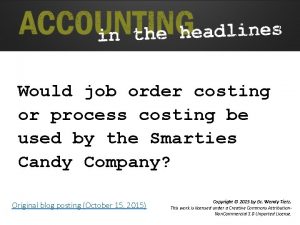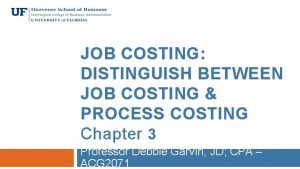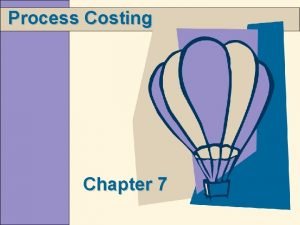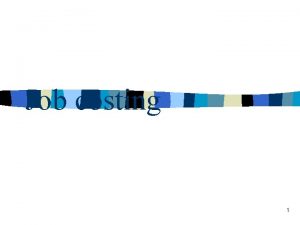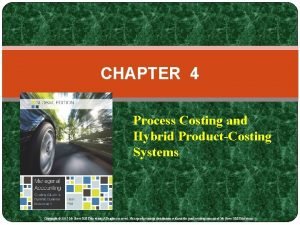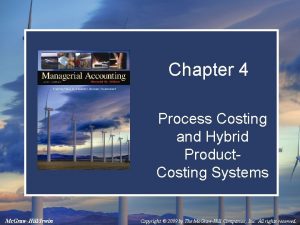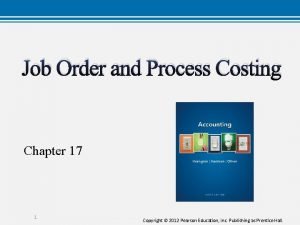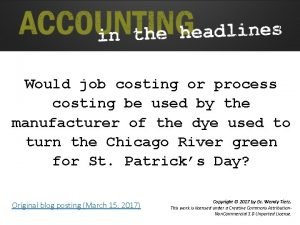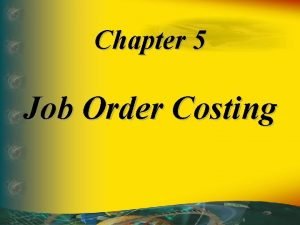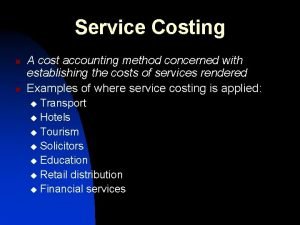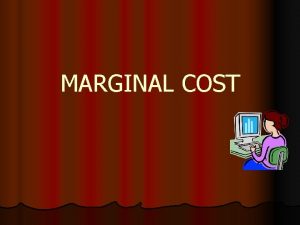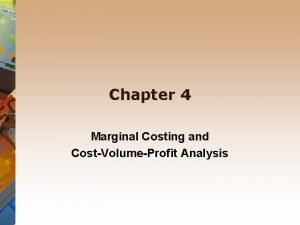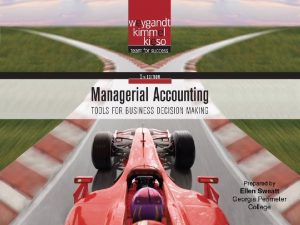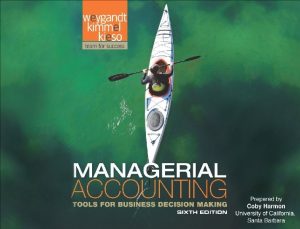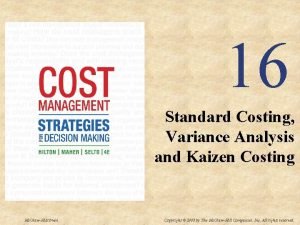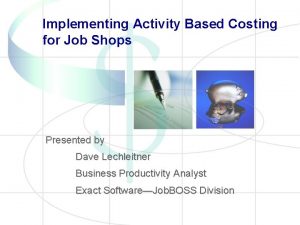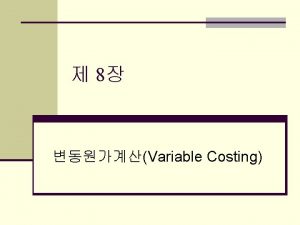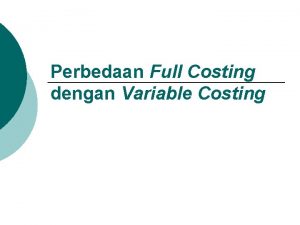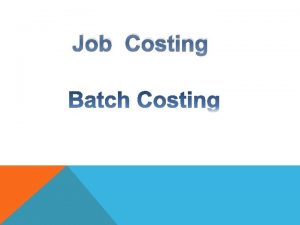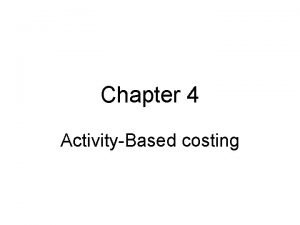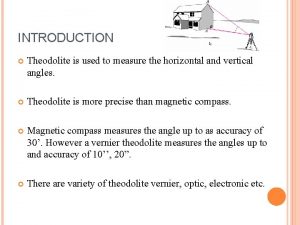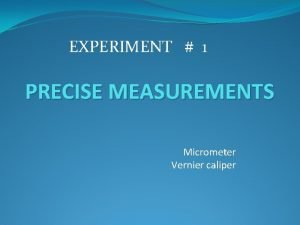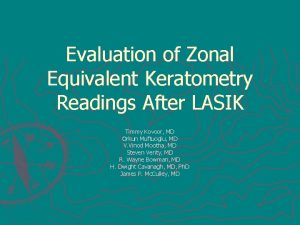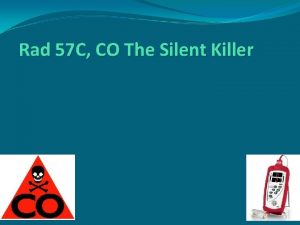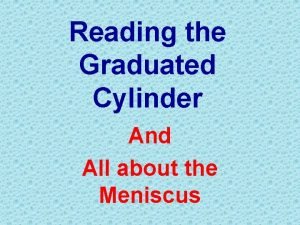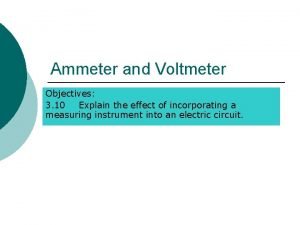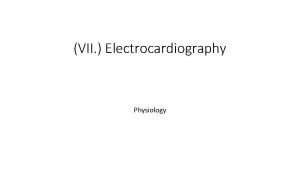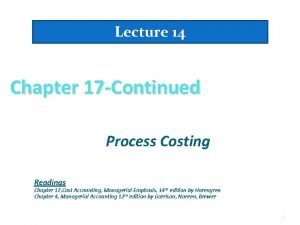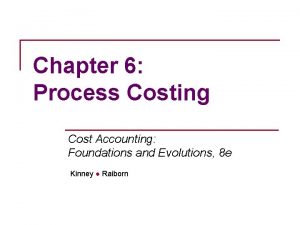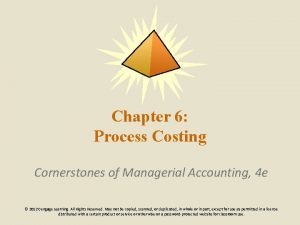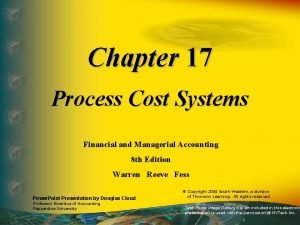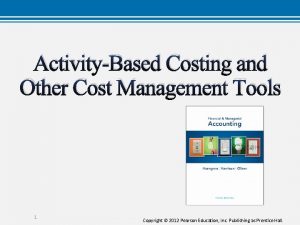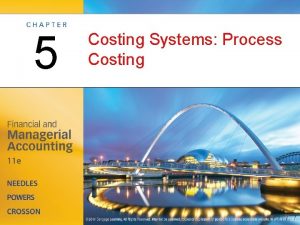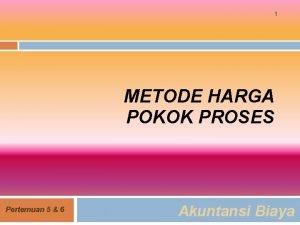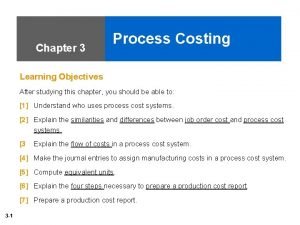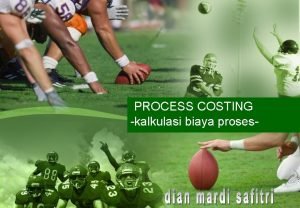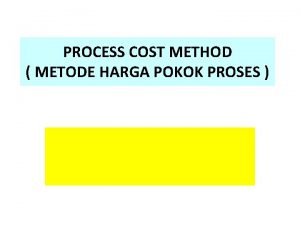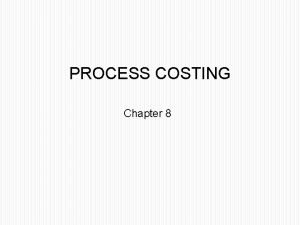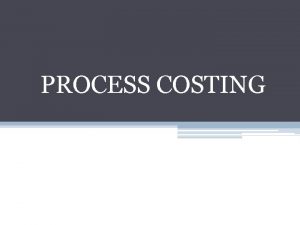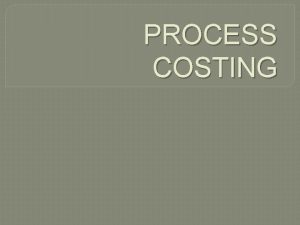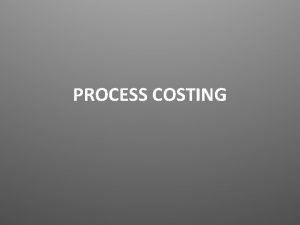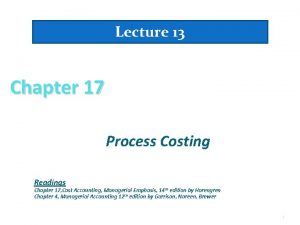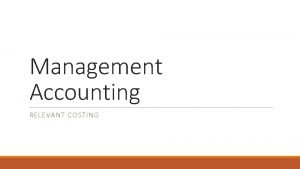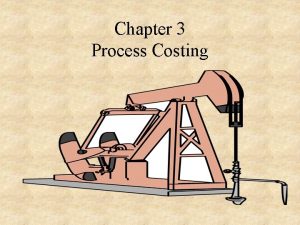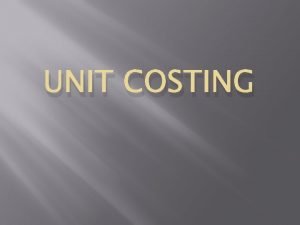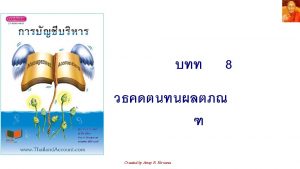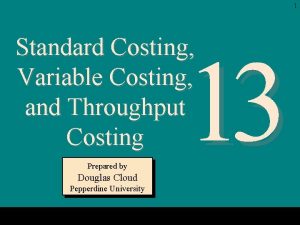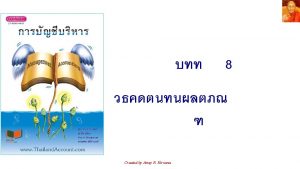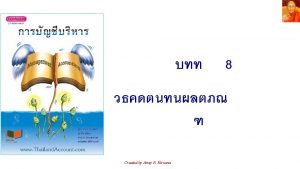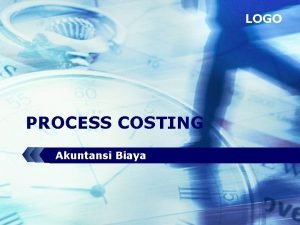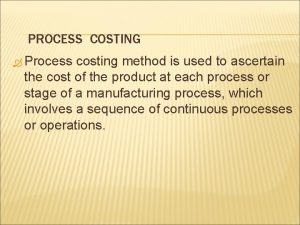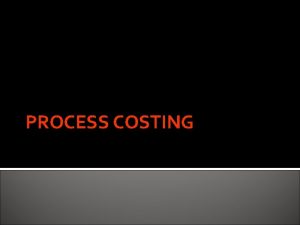Lecture 15 Chapter 17 Continued Process Costing Readings























































- Slides: 55

Lecture 15 Chapter 17 -Continued Process Costing Readings Chapter 17, Cost Accounting, Managerial Emphasis, 14 th edition by Horengren Chapter 4, Managerial Accounting 12 th edition by Garrison, Noreen, Brewer 1

Learning Objectives Record the flow of materials, labor, and overhead through a process cost system. Compute the equivalent units of production using the weighted-average method. Compute the cost per equivalent unit using the weighted-average method. Assign costs to units using the weighted-average method. Compute the equivalent units of production using the FIFO method. Compute the cost per equivalent unit using the FIFO method. Assign costs to units using the FIFO method Allocate service department costs to operating departments using the direct method. To allocate service department costs to operating departments using the step-down method. 2

Equivalent Units – FIFO Method Let’s revisit the Double Diamond Skis example. Assume the following activity is reported in Shaping and Milling Department for May: 3

Equivalent Units – FIFO Method Step 1: 1 Determine equivalent units needed to complete beginning inventory. 4

Equivalent Units – FIFO Method Step 2: 2 Determine units started and completed during the period. 5

Equivalent Units – FIFO Method Step 3: 3 Add the equivalent units in ending working in process inventory. 6

FIFO Example Materials Beginning Work in Process 200 Units 55% Complete 200 × 45% 5, 000 Units Started 4, 600 Units Started and Completed 90 Equivalent Units 4, 600 Units Completed 160 Equivalent Units 4, 850 Equivalent units of production Ending Work in Process 400 Units 40% Complete 400 × 40% 7

FIFO Example Conversion Beginning Work in Process 200 Units 30% Complete 200 × 70% 5, 000 Units Started 4, 600 Units Started and Completed 140 Equivalent Units 4, 600 Units Completed 100 Equivalent Units 4, 840 Equivalent units of production Ending Work in Process 400 Units 25% Complete 400 × 25% 8

Equivalent Units: Weighted Average vs. FIFO As shown below, the equivalent units in beginning inventory are subtracted from the equivalent units of production per the weightedaverage method to obtain the equivalent units of production under the FIFO method. 9

Cost per Equivalent Unit - FIFO Let’s revisit the Double Diamond Skis Shaping and Milling Department for the Month of May to prepare our production report. Beginning work in process: Materials: 55% complete Conversion: 30% complete Production started during May Production completed during May 200 units $ 9, 600 5, 575 $15, 175 5, 000 units 4, 800 units Costs added to production in May Materials cost $ 368, 600 Conversion cost 350, 900 Ending work in process: 400 units Materials: 40% complete Conversion: 25% complete 10

Cost per Equivalent Unit - FIFO The formula for computing the cost per equivalent unit under FIFO method is : Cost per equivalent = unit Cost added during the period Equivalent units of production 11

Cost per Equivalent Unit - FIFO 12

Applying Costs - FIFO Step 1: 1 Record the equivalent units of production in ending work in process inventory. 13

Applying Costs - FIFO Step 2: 2 Record the cost per equivalent unit. 14

Applying Costs - FIFO Step 3: 3 Compute the cost of ending work in process inventory. 15

Cost of Units Transferred Out Step 1: 1 Record the cost in beginning work in process inventory. 16

Cost of Units Transferred Out Step 2: 2 Compute the cost to complete the units in beginning work in process inventory. 17

Cost of Units Transferred Out Step 3: 3 Compute the cost of units started and completed this period. 18

Cost of Units Transferred Out Step 4: 4 Compute the total cost of units transferred out. 19

Reconciling Costs 20

Reconciling Costs 21

A Comparison of Costing Methods In a lean production environment, FIFO and weighted-average methods yield similar unit costs. When considering cost control, FIFO is superior to weighted-average because it does not mix costs of the current period with costs of the prior period. 22

Service Department Allocations 23

Operating Departments An operating department carries out the central purpose of the organization The Accounting Department at your University. An Assembly Department at General Motors. 24

Service Departments A service department does not directly engage in operating activities. The Accounting Department at Macys The Human Resources Department at Walgreens. 25

Interdepartmental Services Service Department Operating Department Costs of the service department become overhead costs to the operating department 26

Allocation Approaches Direct Method Step-Down Method Reciprocal Method 27

Reciprocal Services Service Department 1 When service departments provide services to each other we call them reciprocal services. Service Department 2 28

Direct Method Interactions between service departments are ignored and all costs are allocated directly to operating departments. Service Department (Cafeteria) Operating Department (Machining) Service Department (Custodial) Operating Department (Assembly) 29

Direct Method 30

Direct Method How much of the Cafeteria and Custodial costs should be allocated to each operating department using the direct method of cost allocation? 31

Direct Method 20 $360, 000 × = $144, 000 20 + 30 Allocation base: Number of employees 32

Direct Method $360, 000 × 30 = $216, 000 20 + 30 Allocation base: Number of employees 33

Direct Method 25, 000 $90, 000 × 25, 000 + 50, 000 = $30, 000 Allocation base: Square feet occupied 34

Direct Method 50, 000 $90, 000 × 25, 000 + 50, 000 = $60, 000 Allocation base: Square feet occupied 35

Step Method Once a service department’s costs are allocated, other service department costs are not allocated back to it. Service Department (Cafeteria) Operating Department (Machining) Service Department (Custodial) Operating Department (Assembly) 36

Step Method There are three key points to understand regarding the step method: In both the direct and step methods, any amount of the allocation base attributable to the service department whose cost is being allocated is always ignored. Any amount of the allocation base that is attributable to a service department whose cost has already been allocated is ignored. Each service department assigns its own costs to operating departments plus the costs that have been allocated to it from other service departments. 37

Step Method We will use the same data used in the direct method example. 38

Step Method Allocate Cafeteria costs first since it provides more service than Custodial. 39

Step Method 10 $360, 000 × 10 + 20 + 30 = $60, 000 Allocation base: Number of employees 40

Step Method 20 $360, 000 × 10 + 20 + 30 = $120, 000 Allocation base: Number of employees 41

Step Method 30 $360, 000 × 10 + 20 + 30 = $180, 000 Allocation base: Number of employees 42

Step Method New total = $90, 000 original Custodial cost plus $60, 000 allocated from the Cafeteria. 43

Step Method 25, 000 $150, 000 × 25, 000 + 50, 000 = $50, 000 Allocation base: Square feet occupied 44

Step Method 50, 000 $150, 000 × 25, 000 + 50, 000 = $100, 000 Allocation base: Square feet occupied 45

Reciprocal Method Interdepartmental services are given full recognition rather than partial recognition as with the step method. Service Department (Cafeteria) Operating Department (Machining) Service Department (Custodial) Operating Department (Assembly) Because of its mathematical complexity, the reciprocal method is rarely used. 46

Quick Check Data for Direct and Step Methods The direct method of allocation is used. Allocation bases: l. Business school administration costs (ADMIN): Number of employees l. Business Administration computer services (BACS): Number of personal computers 47

Quick Check How much cost will be allocated from Administration to Accounting? a. $ 36, 000 b. $144, 000 c. $180, 000 d. $ 27, 000 48

Quick Check How much cost will be allocated from Administration to Accounting? a. $ 36, 000 b. $144, 000 c. $180, 000 d. $ 27, 000 20 $180, 000 × = $36, 000 20 + 80 49

Quick Check How much total cost will be allocated from ADMIN and BACS combined to the Accounting Department? a. $ 52, 500 b. $135, 000 c. $270, 000 d. $ 49, 500 50

Quick Check How much total cost will be allocated from ADMIN and BACS combined to the Accounting Department? a. $ 52, 500 b. $135, 000 c. $270, 000 d. $ 49, 500 $90, 000 × 18 = $13, 500 18 + 102 51

Quick Check Data The step method of allocation is used. Allocation bases: l. Business school administration costs (ADMIN): Number of employees l. Business administration computer services (BACS): Number of personal computers 52

Quick Check How much total cost will be allocated from ADMIN and BACS combined to the Accounting Department? a. $35, 250 b. $49, 072 c. $18, 000 d. $26, 333 53

Quick Check How much total cost will be allocated from ADMIN and BACS combined to the Accounting Department? a. $35, 250 b. $49, 072 c. $18, 000 d. $26, 333 54

End of Lecture 15 55
 Job order costing and process costing
Job order costing and process costing Similarities between job order costing and process costing
Similarities between job order costing and process costing Job order costing vs process costing
Job order costing vs process costing Difference between job costing and process costing
Difference between job costing and process costing Job costing vs process costing
Job costing vs process costing Process costing and hybrid product-costing systems
Process costing and hybrid product-costing systems Wip control account
Wip control account Conversion cost formula
Conversion cost formula Cost of production report example
Cost of production report example Process costing adalah
Process costing adalah Job costing with process costing
Job costing with process costing Job order costing process costing
Job order costing process costing Difference between service costing and output costing
Difference between service costing and output costing Absorption costing vs marginal costing
Absorption costing vs marginal costing Difference between job costing and contract costing
Difference between job costing and contract costing Variable costing vs absorption costing
Variable costing vs absorption costing Slidetodoc.com
Slidetodoc.com Advantages of activity based costing
Advantages of activity based costing Abc costing vs traditional costing
Abc costing vs traditional costing Difference between kaizen costing and standard costing
Difference between kaizen costing and standard costing Job shop pricing
Job shop pricing Mixed cost
Mixed cost Perbedaan full costing dan variable costing
Perbedaan full costing dan variable costing Objectives of job costing
Objectives of job costing Chapter 4 activity-based costing solutions
Chapter 4 activity-based costing solutions Objectives of standard costing
Objectives of standard costing Metode full costing dan variable costing
Metode full costing dan variable costing 01:640:244 lecture notes - lecture 15: plat, idah, farad
01:640:244 lecture notes - lecture 15: plat, idah, farad While reading stage
While reading stage Levelling head in theodolite
Levelling head in theodolite Msr and vsr
Msr and vsr Keratometer readings
Keratometer readings Language awareness readings for college writers
Language awareness readings for college writers Confined space gas limits
Confined space gas limits Rad 57 readings
Rad 57 readings Normal abg values
Normal abg values How to read a graduated cylinder
How to read a graduated cylinder Environmental management: readings and cases
Environmental management: readings and cases Responsive readings for christmas
Responsive readings for christmas Thanksgiving responsive readings
Thanksgiving responsive readings Jcu map
Jcu map Ammeter readings
Ammeter readings Normal ecg readings
Normal ecg readings Equivalent units fifo and weighted average
Equivalent units fifo and weighted average The foundation of a process costing system is the
The foundation of a process costing system is the Chapter 8 section 3 cellular respiration
Chapter 8 section 3 cellular respiration Process costing problems and solutions doc
Process costing problems and solutions doc Process costing
Process costing Process costing
Process costing Process costing
Process costing Penambahan bahan pada departemen lanjutan
Penambahan bahan pada departemen lanjutan Cost of production report
Cost of production report Contoh soal process costing 1 departemen
Contoh soal process costing 1 departemen Metode harga pokok proses (process costing)
Metode harga pokok proses (process costing) Examples of process cost system
Examples of process cost system Characteristics of process costing
Characteristics of process costing
